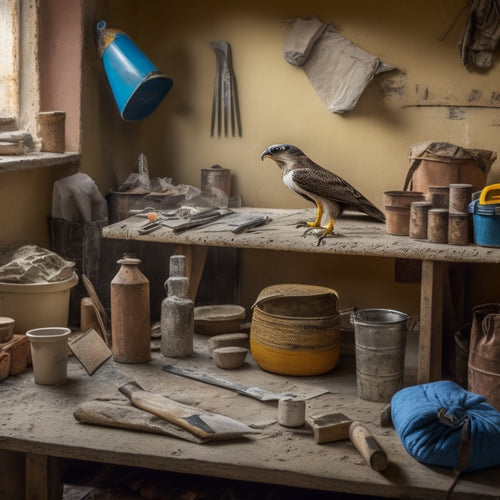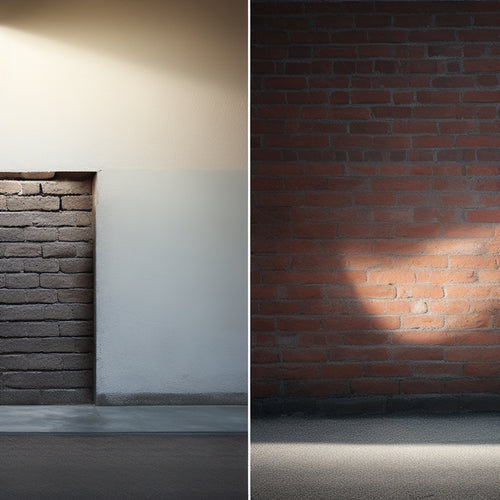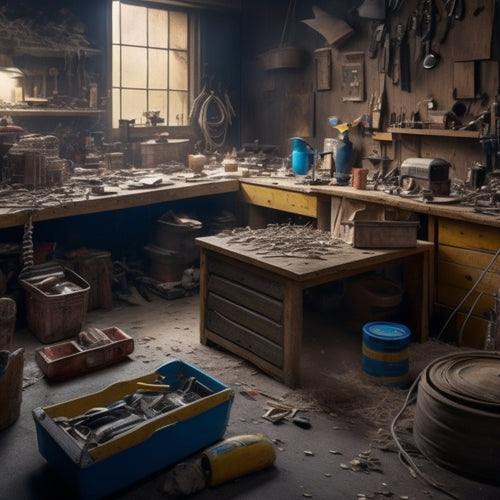
Top 3 Tools for Safe Plaster Ceiling Renovation
Share
When tackling a plaster ceiling renovation, you'll need to prioritize your safety above all else. Invest in a high-quality dust mask, safety goggles, and gloves to protect yourself from hazardous materials and debris. Next, equip yourself with a putty knife or scraper, dustless scraper, and hammer and chisel to efficiently remove the plaster. With these top three tools, you'll be well on your way to a successful renovation. As you progress, you'll discover the importance of specialized equipment and refined techniques that will take your project to the next level.
Key Takeaways
• Wear a dust mask with a HEPA filter to capture 99.97% of particles (0.3 microns) and prevent inhalation of harmful dust.
• Invest in safety goggles with shatter-resistant lenses to protect eyes from debris and dust during plaster ceiling renovation.
• A putty knife or scraper is essential for removing large areas of plaster quickly and efficiently, while a dustless scraper minimizes dust and debris.
• Use a hammer and chisel to break up stubborn plaster before scraping, and always wear durable gloves to protect hands from cuts and abrasions.
• A hard hat is a must-have to protect against falling objects and debris during plaster ceiling renovation, meeting industry standards for impact resistance.
Essential Safety Gear for Renovation
Before you begin plaster ceiling renovation, equip yourself with essential safety gear, including a dust mask, safety goggles, gloves, and a hard hat, to protect yourself from hazardous materials and debris.
You'll be handling materials that can release harmful particles into the air, and you don't want to risk inhaling them or getting them in your eyes. A dust mask will filter out particles, while safety goggles will shield your eyes from flying debris. Gloves will protect your hands from cuts and abrasions, and a hard hat will prevent head injuries from falling objects.
When selecting a dust mask, choose one with a HEPA filter, which can capture 99.97% of particles as small as 0.3 microns.
Make certain your safety goggles have shatter-resistant lenses and a comfortable, snug fit. Your gloves should be durable and provide grip, while your hard hat should meet industry standards for impact resistance.
Don't compromise on safety – investing in quality gear will guarantee you complete the renovation without incident. By taking these precautions, you'll be able to focus on the task at hand, confident that you're protected from harm.
Best Tools for Plaster Removal
With the right tools, you'll be able to efficiently remove old plaster, making way for a smooth renovation process. When it comes to plaster removal techniques, having the correct tools is vital.
You'll need a putty knife or scraper, preferably with a curved or angled blade, to effectively scrape away the old plaster. A 4-6 inch putty knife is ideal for removing large areas of plaster, while a smaller scraper is better suited for tighter spaces and detailed work.
Additionally, a dustless scraper or a vacuum scraper can be used to minimize dust and debris. These effective scraping methods will help you remove the old plaster quickly and efficiently.
For more stubborn areas, a hammer and chisel can be used to break up the plaster before scraping it away. By investing in these essential tools, you'll be well-equipped to tackle even the most challenging plaster removal projects.
Specialized Equipment for Finishing
As you move on to the finishing stage, you'll require specialized equipment to achieve a smooth, even surface, including sanding blocks, joint compound applicators, and textured finish tools. These tools are essential for mastering advanced finishing techniques, guaranteeing a flawless surface that meets your standards.
Sanding blocks, for instance, help you achieve a uniform surface by removing minor imperfections and scratches. Joint compound applicators, on the other hand, enable you to apply the right amount of compound to joints, guaranteeing a seamless finish.
Proper surface preparation is critical at this stage. You'll need to confirm the surface is clean, dry, and free of dust and debris. This will assure a strong bond between the finishing materials and the plaster ceiling.
With the right equipment and techniques, you'll be able to achieve a high-quality finish that meets your expectations. By investing in specialized equipment, you'll have greater control over the finishing process, allowing you to produce exceptional results that will last for years to come.
Frequently Asked Questions
Can I Renovate a Plaster Ceiling With Water Damage or Mold?
You're wondering if you can renovate a plaster ceiling with water damage or mold. The short answer is yes, but it requires caution and expertise.
Before starting plaster ceiling restoration, you must address the underlying issue by employing mold remediation techniques to remove the mold and dry the area completely.
This guarantees a safe and successful renovation. Don't skip this vital step, as it's essential for preventing further damage and potential health risks.
Do I Need a Permit for a Small Plaster Ceiling Renovation Project?
You're wise to wonder if you need a permit for your small plaster ceiling renovation project.
Typically, you'll need to file a permit application with your local authorities, especially if you're dealing with electrical, plumbing, or structural changes.
Review your local renovation guidelines to determine what's required.
Don't risk fines or rework - make certain you comply with regulations to maintain control over your project's timeline and budget.
How Do I Handle Asbestos-Containing Plaster During Renovation?
When handling asbestos-containing plaster during renovation, you'll need to take extreme caution.
First, you'll want to conduct asbestos testing to confirm the presence and extent of the hazardous material.
If test results are positive, it's essential to hire a certified professional for safe removal, as DIY attempts can be deadly.
They'll contain the area, wear personal protective equipment, and use specialized tools to minimize fiber release, ensuring a safe and compliant renovation process.
Can I Reuse Old Plaster Ceiling Materials for the Renovation?
When considering reusing old plaster ceiling materials, you'll need to assess their condition and potential contamination.
It's unlikely you'll be able to reuse them, especially if they contain asbestos.
Instead, explore plaster recycling options or adopt renovation techniques that minimize waste.
You'll want to prioritize safety and efficiency, so carefully evaluate the materials' integrity before making a decision.
How Long Does a Typical Plaster Ceiling Renovation Project Take?
'Ah, you think you're a renovation rockstar, don't you?
'How long will this project take?' you ask, as if you're not secretly wondering if you'll still have a social life by the time it's done.
Listen, buddy, a typical plaster ceiling renovation project takes anywhere from a few days to several weeks, depending on the scope and complexity.
For an accurate time estimation, you'll need to factor in project planning, material prep, and the inevitable 'oops' moments.
Conclusion
As you emerge from the renovation battlefield, triumphant but scarred, you realize that safety gear was your shield, plaster removal tools your sword, and finishing equipment your polishing cloth.
The plaster ceiling, once a formidable foe, now lies conquered, its beauty revealed like a butterfly from a cocoon.
With these top 3 tools, you've tamed the beast, and your reward is a renovated space that shines like a work of art.
Related Posts
-

Top Tools for DIY Home Renovation Plastering Success
To achieve DIY home renovation plastering success, you'll need a range of essential tools. Start with hand tools like...
-

Why Use Concrete Blocks in Home Renovation
You're considering using concrete blocks in your home renovation, and for good reason: they offer a unique combinatio...
-

Why Delay Your Renovation With Poor Tool Management
You're likely unaware that poor tool management is a leading cause of renovation delays, and it's not just about havi...


